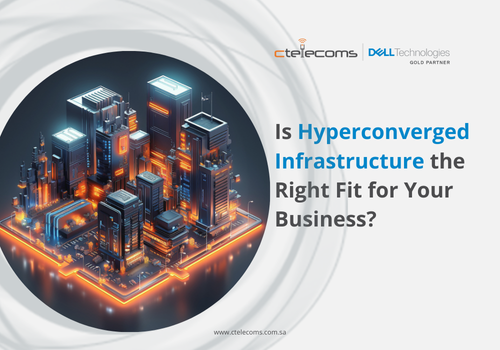

2025/04/12 Computing & Hyper-converged Infrastructure Solutions 29 visit(s) 2 min to read
Ctelecoms

When planning the technological infrastructure for your company, whether it is entirely on-premises or a combination of on-premises and cloud-based services, a key consideration emerges: Hyperconverged Infrastructure, or HCI for short.
This approach is said to offer financial savings, simplified management, and a smoother path for expanding your technological infrastructure. But what exactly is it, and is it a good fit for your business?
Let's make sense of it.
Traditional data centers use a three-tier architecture—network, compute (servers), and storage—managed separately, often by different teams. It’s reliable, but complex and expensive to scale.
Usually, different teams of people would manage each of these parts separately. It worked, but it could get complicated and cost a lot of money when you needed to add more stuff.
Then came Converged Infrastructure. Imagine this as getting all those three parts bundled together by one company. It's like a ready-made package that you can just plug in. It can be easier, but the different parts are still separate pieces of equipment inside the package. Plus, you're pretty much stuck buying more stuff from that same company later on.
Now, Hyperconverged Infrastructure takes things a step further. It squishes the storage and the computers right into the same physical machines. The secret sauce that makes this work is special software called software-defined storage (SDS).
This means you don't need those separate big storage boxes (called SANs) or those fancy, expensive network cables anymore. Instead, your virtual computers can run their programs and keep their data on lots of different machines all at once. This is great because if one machine has a problem, everything keeps running smoothly, and it's super flexible when you need to add more power or storage.
Within a hyperconverged infrastructure (HCI) environment:
The implementation of a streamlined virtualization platform can further enhance the capabilities of HCI. This integration facilitates the concurrent operation of virtual machines, containerized applications, and storage management functionalities within a cohesive and efficient environment.
The resultant benefits include the performance and resilience characteristic of traditional infrastructure architectures, coupled with a significant reduction in the quantity of physical hardware requiring procurement, thermal management, and ongoing maintenance.
While hyperconverged infrastructure (HCI) offers numerous advantages, it is essential to recognize that its suitability is context-dependent and not universally applicable.
Scenarios Favoring HCI Adoption:
Scenarios Where HCI May Be Less Optimal:
Furthermore, prospective adopters should evaluate their preference for either a pre-configured, "turnkey" HCI appliance or a more adaptable, software-defined approach. The latter offers a greater degree of control and customization over the infrastructure environment.
Okay, so you're wondering if hyperconverged infrastructure (HCI) might be a good fit for your company, right?
Basically, HCI is actually a smarter, more streamlined way to power your private cloud. Think of it as making your IT setup more reliable, simpler to manage, and easier to grow – something older setups sometimes struggle with. Especially now that everyone's trying to keep IT costs predictable and have more control, HCI can be a real game-changer.
If you have any interest in learning whether HCI could be a beneficial solution for your company, we are here to assist you in determining its suitability. We can discuss the feasibility of HCI for your specific needs, plan the transition, and ensure that your IT infrastructure operates at its optimal level. Please do not hesitate to contact us if you would like to discuss this matter further.